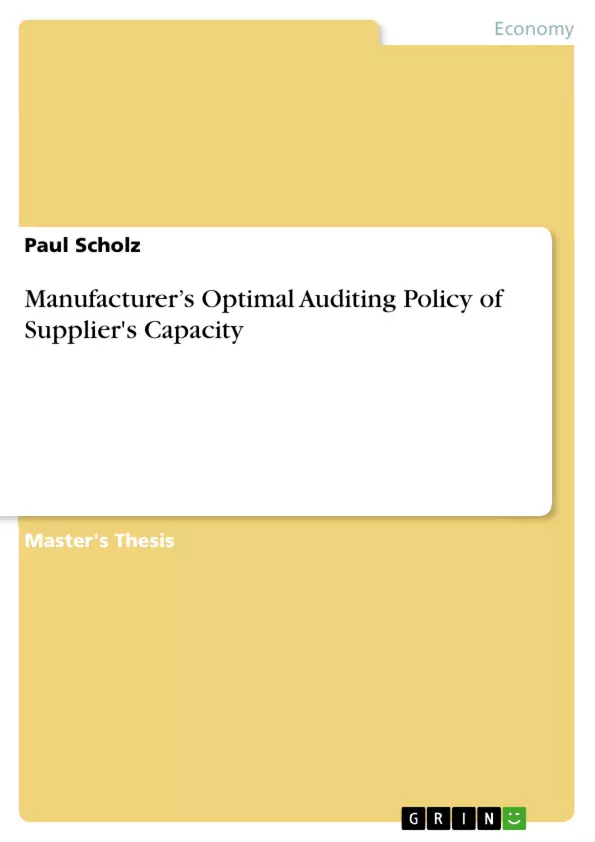This research investigates a manufacturer’s optimal capacity auditing policy in the principal-agent context facing asymmetric information. Supply chain coordination through supplier capacity auditing has the ability to affect both supply chain efficiency and risk management challenges. So far not a lot of research on principal-agent relationships in the manufacturing context has been performed – specifically not on supplier capacity auditing with one party facing asymmetric information. The basic assumption of this model is the contracting relationship of one manufacturer and one supplier.
A price-quantity schedule is offered by manufacturer and the supplier selects one single-period fixed-price contract without any further communication and negotiation. The manufacturer’s decision according to the price-quantity schedules offered is upon order quantity, transfer payment and the audit application probability. The supplier’s production capacity is known to the supplier at all times but unknown to the manufacturer. In addition to that, the demand is stochastically distributed and concretizes after both parties agreed about the contract.
Basic profit functions of the manufacturer and the supplier are adjusted to match the requirements of the manufacturing context. In order to derive optimal closed form solutions, the equations are modified following an approach of Laffont and Martimort. An optimal capacity audit mechanism for a manufacturer who procures components from a supplier possessing private capacity information is pointed out.
Inhaltsverzeichnis (Table of Contents)
- ABSTRACT
- TABLE OF CONTENTS
- 1 INTRODUCTION
- 1.1 Intention and Context of the Research
- 1.2 Motivation and Academic Purpose
- 2 LITERATURE REVIEW
- 2.1 Newsvendor Model: Optimal Inventory and Production Capacity Policy
- 2.2 Competition in the Supply Chain
- 2.3 Principal-Agent Models and Asymmetric Information
- 2.4 Optimal Equilibrium Procurement Strategies
- 2.5 Supplier Auditing
- 3 ORGANIZATION OF THE ARTICLE
- 4 MATHEMATICAL MODEL DEVELOPMENT
- 4.1 Pre-Assumptions and External Contracting Conditions in the Manufacturing Context
- 4.2 Application-Implicit Transformation of Action into Reasonable Variables for the Mathematical Model
- 4.3 Mathematical Model Formulation
- 4.4 Mathematical Model Specification
- 4.4.1 Assumption of Two Types of Suppliers and Two Different Production Schedules
- 4.4.2 Simplification Approach: Reduction of Decision Variables
- 4.4.3 Individual and Overall Welfare Considerations
- 4.5 Optimality Analysis
- 4.5.1 Conversion of Min/Max Functions
- 4.5.2 Optimal Capacity Auditing Probability of the Inefficient Supplier Type
- 4.5.3 Optimal Order Quantities for the Efficient and Inefficient Supplier Type
- 5 NUMERICAL STUDY AND SENSITIVITY ANALYSIS
- 5.1 Transfer of the General Model into MATLAB
- 5.2 MATLAB Solver for Optimal Selection of Decision Variables
- 5.3 Sensitivity Analysis
- 5.3.1 Impact of Efficient Supplier Occurrence Probability on Manufacturer's Profit
- 5.3.2 Impact of Marginal Retailing Price Level on Manufacturer's Profit
- 5.3.3 Impact of Efficient Supplier Occurrence Probability on Inefficient Supplier Capacity Audit Probability
- 5.3.4 Impact of Inefficient Supplier's Untrustworthiness Penalty on Inefficient Supplier Capacity Audit Probability
- 5.3.5 Impact of Market Demand Variation on Optimal Order Quantity
- 5.3.6 Impact of Efficient Supplier Occurrence Probability on Optimal Order Quantity
- 6 SUMMARY AND FUTURE OUTLOOK
- 6.1 Summary of Results and Research Process
- 6.2 Limitations and Future Outlook
- LIST OF NOMENCLATURE
- TABLE OF TABLES
- TABLE OF FIGURES
- REFERENCE
- APPENDIX
- Reformulation as a Linear Program
Zielsetzung und Themenschwerpunkte (Objectives and Key Themes)
This research investigates the optimal capacity auditing policy for a manufacturer in a principal-agent context, where the supplier possesses private information about their production capacity. The primary objective is to determine how the manufacturer can best utilize capacity audits to mitigate the risk of supplier opportunism and improve supply chain efficiency.
- Supply Chain Coordination and Efficiency
- Principal-Agent Relationships and Asymmetric Information
- Optimal Auditing Mechanisms
- Supplier Incentives and Contract Design
- Risk Management in Supply Chains
Zusammenfassung der Kapitel (Chapter Summaries)
The thesis begins by introducing the context and motivation for the research, highlighting the increasing importance of supply chain coordination and the challenges posed by asymmetric information. Chapter 2 provides a comprehensive literature review, exploring relevant concepts from the newsvendor model, principal-agent theory, and supplier auditing. Chapter 4 presents the mathematical model development, outlining the assumptions, variables, and equations used to analyze the manufacturer's optimal auditing policy. This chapter includes an in-depth analysis of the model's optimality conditions. Chapter 5 presents the results of a numerical study and sensitivity analysis, demonstrating the impact of various factors on the manufacturer's profit and the optimal auditing probability. The thesis concludes with a summary of the findings and a discussion of potential future research directions.
Schlüsselwörter (Keywords)
The research focuses on supply chain efficiency, supply chain coordination, newsvendor model, principal-agent theory, asymmetric information, and supplier capacity auditing. The key concepts explored include contract design, incentive compatibility, risk mitigation, and optimal auditing mechanisms. The research also draws on theoretical frameworks such as the BiLieF project, which provides insights into the dynamics of information asymmetry in supply chains.
- Quote paper
- Paul Scholz (Author), 2016, Manufacturer’s Optimal Auditing Policy of Supplier's Capacity, Munich, GRIN Verlag, https://www.grin.com/document/369835



